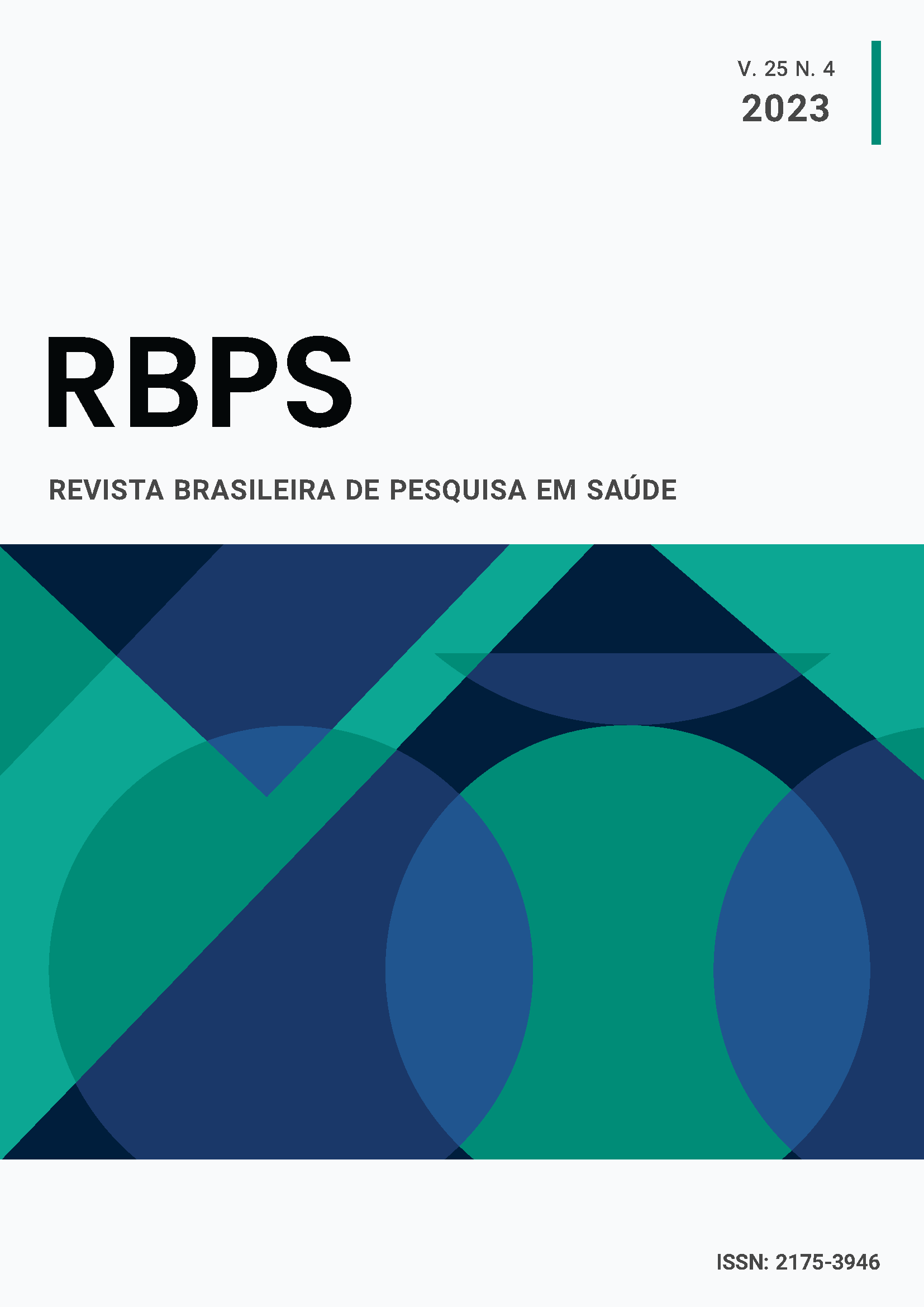Prophylactic activity of caffeine in controlling Parkinson’s disease
DOI:
https://doi.org/10.47456/rbps.v25i4.40561Keywords:
Parkinson’s disease, Caffeine, ControlAbstract
Introduction: In the world, it is estimated that Parkinson’s disease (PD) is the second most common degenerative neuropathology, being preceded only by Alzheimer’s disease. It is an idiopathic disease, which results from individual interactions with environmental factors, which lead to biochemical dysfunctions. It is known, however, that methylxanthines, like caffeine, have biological activities that are correlated with the pathophysiology of dementia. Objective: To verify the prophylactic activity of caffeine in controlling PD. Methods: A literature review was carried out by electronic search of scientific articles, published between 2015-2020, in the Scientific Electronic Library (SciELO), Latin American and Caribbean Center on Health Sciences Information (BIREME-PAHO-WHO), and the US National Library of Medicine (PubMed). The search was based on the search for the keywords “caffeine and Parkinson disease”. Results: Ten articles were selected, of which five suggested that caffeine has therapeutic potential in the treatment of PD in an animal model; two indicated that, in vitro, caffeine has therapeutic potential; three did not correlate caffeine with clinical improvement in PD, in cases of already established disease in humans; two indicated that caffeine consumption as a protective factor for the development of PD. Conclusion: Caffeine has antiparkinsonian activity in vitro and in vivo. However, this effect is not reproduced in clinical trials, which indicates translational ineffectiveness. However, there is still a need for larger multicentric clinical studies, with caffeine alone, aimed at investigating its usefulness, or not, as an adjuvant therapy in the treatment of PD.
Downloads
References
Werner P, Klaus S, Caroline MT, Glenda MHalliday, Patrik B, Jens V, Anette-Eleonore S, Anthony EL. Parkinson disease. [Inter¬net]. Nat Rev Dis Primers. 2017 [cited 2020 Mar 14]; 3;17013. Available from: https://pubmed.ncbi.nlm.nih.gov/28332488/.
Organização Mundial da Saúde (OMS). Distúrbios neurológicos: desafios à saúde pública. Genebra: Serviços de Produção de Doc¬umentos da OMS. Genevre: World Health Organization; 2006 [cited 2023 Dec 21]. 232p. Available from: https://www.who.int/publications/i/item/9789241563369.
Fereshtehnejad SM, Shafieesabet M, Rahmani A, Delbari A, Lökk J. Medium-to-high prevalence of screening-detected par¬kinsonism in the urban area of Tehran, Iran: data from a com¬munity-based door-to-door study. [Internet]. Neuropsychiatry Dis Treat. 2015 [cited 2020 Mar 14]; 11;321‐332. Available from: https://www.ncbi.nlm.nih.gov/pmc/articles/PMC4327401/.
Georgiev, D, Hamberg, K, Hariz, M, Forsgren, L, Hariz, G‐M. Gender differences in Parkinson’s disease: A clinical per¬spective. [Internet]. Acta NeurolScand. 2017 [cited 2020 Mar 14]; 136:570-584. Available from: https://pubmed.ncbi.nlm.nih.gov/28670681/.
Saavedra MJS, Millán PA, Buriticá HOF. Introducción, epidemi¬ología y diagnóstico de laenfermedad de Parkinson. [Internet]. ActaNeurolColomb. 2019 [cited 2020 Mar 15]; 35;2-10. Available from: http://www.scielo.org.co/scielo.php?script=sci_arttex-t&pid=S0120-87482019000500002.
Leszek J, Barreto GE, Gąsiorowski K, Koutsouraki E, Ávi¬la-Rodrigues M, Aliev G. Inflammatory Mechanisms and Oxidative Stress as Key Factors Responsible for Progression of Neurodegeneration: Role of Brain Innate Immune System. [Internet]. CNS NeurolDisord Drug Targets. 2016 [cited 2020 Mar 15]; 15(3):329‐336. Available from: https://pubmed.ncbi.nlm.nih.gov/26831258/.
Rizek P, Kumar N, Jog, MS. An update on the diagnosis and treat¬ment of Parkinson disease. [Internet]. Cmaj. 2016 [cited 2020 Mar 17]; 188(16):1157-1165. Available from: https://pubmed.ncbi.nlm.nih.gov/27221269/.
Castañeda-Garzón AS, Urrego-Duque L.F, Sanchez-Corre¬dor M. C..Variantes moleculares enelgen PARK2 en pacientes colombianos conenfermedad de Parkinson.Estudio piloto entre el 2013 y 2014. [Internet]. Revista Médicas UIS. 2017 [cited 2020 Mar 19]; 30(3):31-38. Available from: https://revistas.uis.edu.co/index.php/revistamedicasuis/article/view/7293.
Magrinelli F, Picelli A, Tocco P, Federico A, Roncari L, Smania N et al. Pathophysiology of motor dysfunction in Parkinson’s dis¬ease as the rationale for drug treatment and rehabilitation. [Inter¬net]. Parkinson’s disease. 2016 [cited 2020 Mar 18]; 2016. Avail¬able from: https://pubmed.ncbi.nlm.nih.gov/27366343/.
Kalia LV, Lang AE. Parkinson disease in 2015: Evolving basic, pathological and clinical concepts in PD. [Internet]. Nat RevNeurol. 2016 [cited 2020 Mar 25]; 12(2):65‐66. Available from: https://pubmed.ncbi.nlm.nih.gov/26782330/.
Bertolucci PHF, Ferraz HB, Barsottini OGP e Pedroso JL. Neu¬rologia: Doença de Parkinson Diagnóstico e Tratamento. 2. ed. Barueri: Manole; 2016. p. 429-455.
Petrovic M, Stefanova E, Ziropadja L, Stojkovic T, &Kostic. Neu¬ropsychiatric symptoms in Serbian patients with Parkinson’s disease. [Internet]. Journal of the Neurological Sciences. 2016 [cited 2020 Apr 1]; 367:342-346. Available from: https://pubmed.ncbi.nlm.nih.gov/27423616/.
Carvalho LOR, Valério DGB, Nóbrega HMG, Dantas ICM, Leite NSB, Sousa MNA. Influência do Café na Doença de Parkinson. [Internet]. Revista Brasileira de Educação e Saúde. 2019 [cited 2020 Apr 1]; 9(2):41-47. Available from: https://www.gvaa.com.br/revista/index.php/REBES/article/view/6558.
Ascherio A, Schwarzschild MA. The epidemiology of Parkin¬son’s disease: risk factors and prevention. [Internet]. The Lancet Neurology. 2016 [cited 20220 Apr 3]; 15(12):1257-1272. Available from: https://pubmed.ncbi.nlm.nih.gov/27751556/.
Armstrong M J. Okun MS. Diagnosis and treatment of Parkin¬son disease: a review. [Internet]. Jama. 2020 [cited 2020 Apr 5]; 323(6):548-560. Available from: https://pubmed.ncbi.nlm.nih.gov/32044947/.
Bastide MF, Meissner WG, Picconi, B, Fasano S, Fernagut, PO, Feyder M, et al. Pathophysiology of L-dopa-induced motor and non-motor complications in Parkinson’s disease. [Internet]. Progress in neurobiology. 2015 [cited 2020 Apr 9]; 132:96-168. Available from: https://pubmed.ncbi.nlm.nih.gov/26209473/.
Ronald BP, Julius A, Amelie P, Lawrence J, Mariana M, David G, Sarah F, Renato PM, Slike AC, Adriana M, Andrew B, Douglas H, Anthony EL. Caffeine as symptomatic treatement for Parkin¬son disease (Coffe-PD): A randomized trial. [Internet]. Neurol¬ogy. 2017 [cited 2020 Apr 15]; 87(17):1795-1803. Available from: https://pubmed.ncbi.nlm.nih.gov/28954882/.
Schepici G, Silvestro S, Bramanti P, Mazzon E. Caffeine: An Over¬view of Its Beneficial Effects in Experimental Models and Clinical Trials of Parkinson’s Disease. [Internet]. International Journal of Molecular Sciences. 2020 [cited 2020 Apr 20]; 21(13):4766. Availa¬ble from: https://pubmed.ncbi.nlm.nih.gov/32635541/.
Soliman AM, Fathalla AM, Moustafa AA. Dose-dependent neu¬roprotective effect of caffeine on a rotenone-induced rat model of parkinsonism: A histological study. [Internet]. Neuroscience letters. 2016 [cited 2020 Mat 3]; 623:63-70. Available from: https://pubmed.ncbi.nlm.nih.gov/27132082/.
Hong CT, Chan L, Bai CH. The Effect of caffeine on the risk and progression of Parkinson’s Disease: A meta-analysis. [Internet]. Nutrients. 2020 [cited 2020 May 3]; 12(6):1860. Available from: https://www.ncbi.nlm.nih.gov/pmc/articles/PMC7353179/.
Khadrawy YA, Salem A M, El-Shamy KA, Ahmed EK, Fadl NN, Hosny EN. Neuroprotective and therapeutic effect of caffeine on the rat model of Parkinson’s disease induced by rotenone. [Inter¬net]. Journal of Dietary Supplements. 2017 [cited 2020 May 7]; 14(5):553-572. Available from: https://pubmed.ncbi.nlm.nih.gov/28301304/.
Manalo RVM, Medina PMB. Caffeine reduces deficits in mech¬anosensation and locomotion induced by L-DOPA and protects dopaminergic neurons in a transgenic Caenorhabditis elegans model of Parkinson’s disease. [Internet]. Pharmaceutical Biol¬ogy. 2020 [cited 2020 May 20]; 58(1):721-731. Available from: https://pubmed.ncbi.nlm.nih.gov/32715838/.
Oñatibia‐Astibia A, Franco R, Martínez‐Pinilla E. Health ben¬efits of methylxanthines in neurodegenerative diseases. [Inter¬net]. Molecular nutrition & food research. 2017 [cited 2020 May 27]; 61(6):1600670. Available from: https://pubmed.ncbi.nlm.nih.gov/28074613/.
Yanan L, Xiangpeng R, Wu Z, Zhenhai Z, Yingzi G, Zhidong H, WEI G, Xingjun C, Fei L, Jiang-Fan C. Chronic caffeine treat¬ment protects against α-synucleinopathy by reestablishing autophagy activity in the mouse striatum. [Internet]. Frontiers in neuroscience. 2018 [cited 2020 Jun 1]; 12:301. Available from: https://pubmed.ncbi.nlm.nih.gov/29770111/.
KardanI J, Roy I. Understanding caffeine’s role in attenuating the toxicity of α-synuclein aggregates: Implications for risk of Par¬kinson’s disease. [Internet]. ACS chemical neuroscience. 2015 [cited 2020 Jun 12]; 6(9):1613-1625. Available from: https://pub-med.ncbi.nlm.nih.gov/26167732/.
Kolahdouzan M, Hamadeh MJ. The neuroprotective effects of caffeine in neurodegenerative diseases. [Internet]. CNS neuro¬science & therapeutics. 2017 [cited 2020 Jun 15]; 23(4):272-290. Available from: https://pubmed.ncbi.nlm.nih.gov/28317317/.
Vega A, León JA, Reyes SM, Miranda SY. Componentes Bio¬activos de Diferentes Marcas de Café Comerciales de Panamá. Relación entre Ácidos Clorogénicos y Cafeína. [Internet]. Inf. tecnol. La Serena. 2018 [cited 2020 Jun 19]; 29(4):43-54. Avail¬able from: https://www.scielo.cl/scielo.php?script=sci_arttex¬t&pid=S0718-07642018000400043.
Hu GL, Wang X, Zhang L, Qiu MH. The sources and mecha¬nisms of bioactive ingredients in coffee. [Internet]. Food & Func¬tion. 2020 [cited 2020 Jun 23]; 10(6):3113-3126. Available from: https://pubmed.ncbi.nlm.nih.gov/31166336/.
Fuchs T, Loureiro MDP, Macedo LE, Nocca D, Nedelcu M, Costa-Casagrande TA. Animal models in metabolic syndrome. [Internet]. Revista do Colégio Brasileiro de Cirurgiões. 2018 [cited 2020 Jun 29]; 45(5). Available from: https://pubmed.ncbi.nlm.nih.gov/30379216/.
Downloads
Published
How to Cite
Issue
Section
License
Copyright (c) 2023 Brazilian Journal of Health Research

This work is licensed under a Creative Commons Attribution-NonCommercial-NoDerivatives 4.0 International License.
Authors and reviewers must disclose any financial, professional, or personal conflicts of interest that could influence the results or interpretations of the work. This information will be treated confidentially and disclosed only as necessary to ensure transparency and impartiality in the publication process.
Copyright
RBPS adheres to the CC-BY-NC 4.0 license, meaning authors retain copyright of their work submitted to the journal.
- Originality Declaration: Authors must declare that their submission is original, has not been previously published, and is not under review elsewhere.
- Publication Rights: Upon submission, authors grant RBPS the exclusive right of first publication, subject to peer review.
- Additional Agreements: Authors may enter into non-exclusive agreements for the distribution of the RBPS-published version (e.g., in institutional repositories or as book chapters), provided the original authorship and publication by RBPS are acknowledged.
Authors are encouraged to share their work online (e.g., institutional repositories or personal websites) after initial publication in RBPS, with appropriate citation of authorship and original publication.
Under the CC-BY-NC 4.0 license, readers have the rights to:
- Share: Copy and redistribute the material in any medium or format.
- Adapt: Remix, transform, and build upon the material.
These rights cannot be revoked, provided the following terms are met:
- Attribution: Proper credit must be given, a link to the license provided, and any changes clearly indicated.
- Non-Commercial: The material cannot be used for commercial purposes.
- No Additional Restrictions: No legal or technological measures may be applied to restrict others from doing anything the license permits.

























